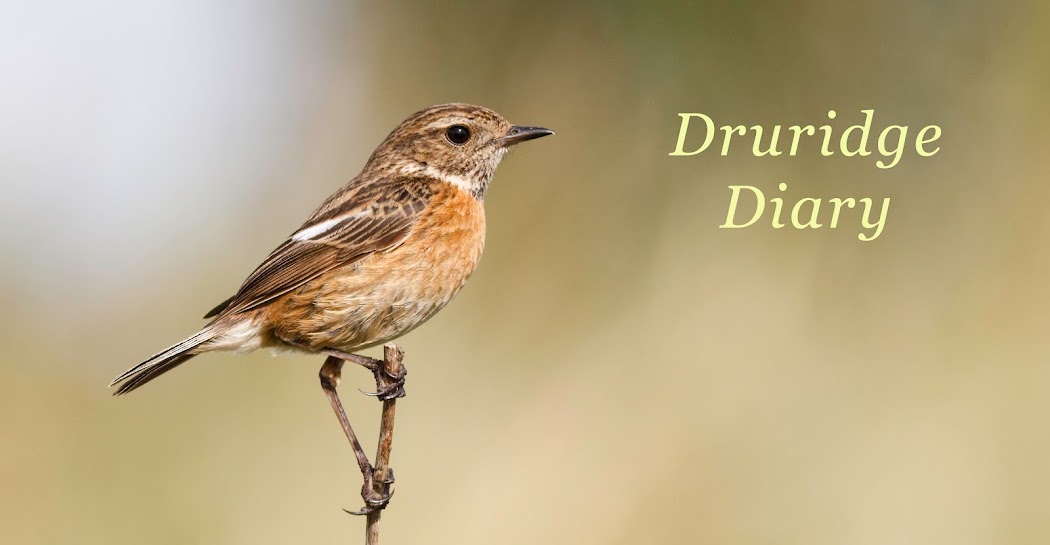I had a difficult decision to make yesterday morning - do as I had planned to do, and go to Druridge and ring some birds or go and twitch the (probable, as it was then) Broon Shrike on Holy Island?
I like seeing rare birds, especially in Northumberland but I hate twitching and I hate twitches - they usually end up disappointing, I either don't see the bird (usually because of I've put going to see it off for too long) or I do see it but the experience is disappointing. Twitching does attract the worst kind of birdwatcher, and occasionally, twitches bring out the worst in otherwise perfectly normal birdwatchers. Ethically, driving 100 miles to see a bird doesn't stack-up either.
We went ringing.
It was worthwhile, we caught 42 birds (38 new, 4 retraps). Amongst the usual autumnal species we caught two Lesser Whitethroats, both were carefully examined to eliminate rarer eastern races but nothing pointed towards to that. Lesser Whitethroats are scarce anyway but arriving with Yellow-browed Warblers (we caught one of these) in mid-October, they need to be carefully scrutinised. We caught a few Long-tailed Tits, Goldcrests, Lesser Redpolls and probably the rarest bird for the patch - Treecreeper.
Again this was scrutinised for 'northern' race but it was a 'brittanica'.
 |
Treecreeper
|
 |
| Yellow-browed Warbler |
 |
| Lesser Whitethroat |
Other than ringing, a Woodcock was flushed as we set the nets up, first of the autumn, and a Short-eared Owl arrived in-off the sea. It was immediately mobbed by crows that pushed it higher and higher until it disappeared off west. A female bullfinch was interesting as was a flock of 17 Greenfinch heading north over the bushes - a really notable record for the patch.
 |
| Short-eared Owl - in-off. |
I had a quick look offshore in the evening. There was strong Gannet and Kittiwake passage, a Slavonian Grebe and a handful of Red-throated Divers were on the Sea.
 |
| Juvenile Great Black-backed Gull |
Friday was forecast to have lighter winds and generally settled and was time to hatch our much procrastinated plan to try and catch the finch flock in the dunes north of the turning circle, Holy Island and the Broon Shrike would have to wait.
It was windier and brighter than we would've liked but we set up two two-shelf nets through the weedy dunes where the finch-flock congregate. Whilst we were setting up, a Lapland Bunting went north, calling.
Despite the 'nice' weather (not nice for ringing) it was quite successful, for catching Reed Buntings at least, ten of them, we also caught two Chaffinch, two Linnet and a Dunnock. This operation had potential but the window is narrow before the cows arrive.
 |
One of ten Reed Buntings
|
It was quite mild in the sunshine and out of the nor'easter wind, which brought out a few insects.
 |
Small Copper butterfly
|
 |
Eupeodes sp Hoverlfy
|
After ringing, I had a wander around the bushes. By the turning-circle there was a Chiffchaff, Yellow-browed Warbler (the one we ringed yesterday probably) and a Lesser Whitethroat that was only seen briefly but the head looked good for an eastern-race bird.
 |
Wren
|
 |
Goldcrest - a male, doing an impression of a squash ball
|
 |
| Inquisitive or miserable-looking? |
I finished with a look on the sea. As I was staring out into the horizon, I was startled by a voice from below " Excuse me, are you the chap who writes the blog?"
Me - "Druridge Diary? yes that's me"
Him - " I follow it and read it regularly, I thought it must be you, so I though I'd say hello"
What a really nice thing to do. I'm pleased someone reads this. I forgot to ask his name, but whoever you are, do leave a comment below if you read this, it was really nice of you to stop and say hello!
I might go to Holy Island tomorrow...



























































